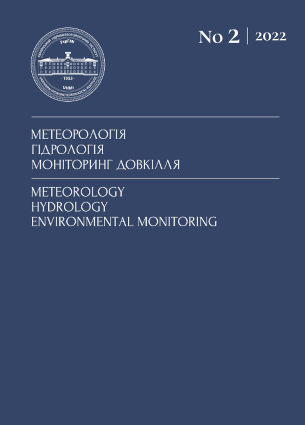SIGNATURES OF WILDFIRES CAUSED BY HOSTILITIES USING THE RESULTS OF SPACE PHOTOGRAPHY
Ukrainian Hydrometeorological Institute of State Emergency Service of Ukraine and National Academy of Sciences of Ukraine
https://orcid.org/0000-0002-8363-6885
Abstract
References
1. Bondar, O., Ivanenko, I., Shust, V., Kantsurak, V., Kokhan, O. (2020). Improving environmental control of particularly dangerous areas with the help of space probing. Ecological sciences. No. 5 (32). 8. [In Ukrainian]
2. Vyshniakov, V.Yu., Nahaievskyi, V.M., Shelestiuk, Yu.O. (2015). Analysis and implementation of subsoil monitoring models based on Suomi NPP data. Environmental safety and nature management. No. 2 (18). 87-94. [In Ukrainian]
3. Havrys, A. P., Moreniuk, R. Ya., Harasymiuk, I. M. (2019). Method of fire areas localization on the basis of remote sensing data. Scientific Bulletin of UNFU. 29, 8. 36-42. [In Ukrainian]
4. Hapon, S.V., Putrenko, V.V. (2020). Fires monitoring proceeded on the territory of united territorial communities by means of geomatics // Ecology. Man. Society: materials of the XXI International Scientific and Practical Conference (Kyiv, 2020). 283-284. [In Ukrainian]
5. Dubrovskyi, V., Parkhisenko,Ya.V., Petrochenko, O.Yu., Potapenko, L.S., Riabokonenko O.D, Shtepa Yu.N. (2002). Space monitoring of forest fires based on NOAA images at UCMZR. Space science and technology. Vol. 8, 2-3. 246-248. [In Ukrainian]
6. Zholobak. H. M. (2010). National experience of satellite monitoring of forest areas of Ukraine. Space science and technology. Vol. 16. No. 3. 46-54 [In Ukrainian]
7. Zibtsev S.V., Soshenskyi, O.M., Humeniuk, V.V., Koren, V.A. (2019). Long term dynamics of forest fires in Ukraine. Ukr. Journal of Forest and Wood Science. Vol. 10. No. 3. 27-40 [In Ukrainian]
8. Zibtsev, S.V., Myroniuk, V.V. (2018). Analysis of spatial and temporal characteristics of the number and area of natural fires on the territory of Eastern Ukraine (occupied territories) [Electronic resource]. Kyiv: Regional Eastern European Fire Monitoring Center (REEFMC), National University of Bioresources and Nature Management of Ukraine, 18. [In Ukrainian]
9. Lishchenko, L.P., Shevchuk, R.M., Filipovych, V.Ye. (2022). Methodology of satellite monitoring of peatlands for the purpose of determining their fire-hazardous state and assessing the risks of fires occurring on them. Ukrainian Journal of Earth Remote Sensing. 9 (1). 17 [In Ukrainian]
10. Oreshchenko, A.V., Osadchyi, V.I., Savenets, M.V., Balabukh, V.O. (2020). Detection and monitoring of potentially dangerous fires on the territory of Ukraine based on satellite scanning data. Visnyk of the National Academy of Sciences of Ukraine. No. 11. 33-44 [In Ukrainian]
11. Oreshchenko, A. (2022). The project 'Forest fire monitoring system': how is it done? — technologies and competencies // Ukrainian Polissia: problems and trends of modern development: materials of the II All-Ukrainian Scientific and Practical Conference (Nizhyn, February 10-11, 2022). Nizhin: NSU named after Gogol, 110-114 [In Ukrainian]
12. Postova, A. (2022). Fires in the ecosystems of Ukraine due to hostilities // Problems of the rational use of the socio-economic, ecological-energy, regulatory and legal potential of Ukraine and its regions: abstracts of the 2nd International Scientific and Practical Conference (Lutsk, June 1, 2022). Lutsk: Volyn Polygraph, 65. [In Ukrainian]
13. Savkov, P., Levinskova, N., Bondarchuk, H., Postarnychenko, N. (2021). Geoinformation systems in the monitoring of forest resources. Military-Special Sciences. 1(45). 71-75 [In Ukrainian]
14. Talerko, M. (2020). Application of the FRP (Fire Radiative Power) value to estimate the emission of radionuclides into the atmosphere due to forest fires in the exclusion zone in April 2020. Nuclear power and environment. 4 (19). 66-74. [In Ukrainian]
15. Ahmad A. A. Alkhatib (2014). A Review on Forest Fire Detection Techniques. International Journal of Distributed Sensor Networks. Vol. 2014, Article ID 597368, 12 p. http://dx.doi.org/10.1155/2014/597368.
16. An operational system for the assimilation of the satellite information on wild-land fires for the needs of air quality modelling and forecasting. (2009). M. Sofiev, R. Vankevich, M. Lotjonen [et al.] // Atmos. Chem. Phys. 9. 6833−6847.
17. Baird, R. A. (2006). Pyro-Terrorism —The Threat of Arson-Induced Forest Fires as a Future Terrorist Weapon of Mass Destruction. Studies in Conflict & Terrorism. Vol. 29. Issue 5. 415-428. https://doi.org/10.1080/10576100600698477.
18. Dinc, P., Eklund, L., Shahpurwala, A. et al. (2021). Fighting Insurgency, Ruining the Environment: the Case of Forest Fires in the Dersim Province of Turkey. Human Ecology. Vol. 49. 481–493. https://doi.org/10.1007/s10745-021-00243-y.
19. Dinc, P. (2021). Forest Fires in Dersim and Sirnak. Conflict and Environmental Destruction // Ecological solidarity and the kurdish freedom movement: Thought, practice, challenges, and opportunities. Lund: Ecological Solidarity and the Kurdish Freedom Movement, 266 p.
20. Finch, F. R. (1996). This Land Is Our Land: The Environmental Threat of Army Operations. International Law Studies. Vol. 69. 99-115.
21. Ichoku C. A. Kaufman J. Y. (2005). Method to Derive Smoke Emission Rates from MODIS Fire Radiative Energy Measurements. IEEE Transactions on Geoscience and Remote Sensing. Vol. 43 (11). 2636−2649.
22. Khoir, A. N. Ooi1, M.C. G., Liew J., Suradi, Kurniawan, A., Ni’amillah, A. (2021). MODIS-derived fire spatial and temporal distribution during haze season in Southeast Asia using empirical orthogonal function. IOP Conf. Series: Earth and Environmental Science 880 012003. doi:10.1088/1755-1315/880/1/012003.
23. Lawrence M. J., Stemberger H. L. J., Zolderdo A. J., Struthers D. P., Cooke S. J. (2015). The effects of modern war and military activities on biodiversity and the environment. Environmental Reviews. Vol. 23, Nо 4. 443-460. https://doi.org/10.1139/er-2015-0039.
24. Lishchenko, L., Pazynyzh, N. (2016). Monitoring of peat bogs areas to identify fire hazards by remote sensing. Ukrainian journal of remote sensing. (8). 29-39.
25. The Environmental Consequences of War: Legal, Economic, and Scientific Perspectives. Jay E. Austin (Editor), Carl E. Bruch (Editor). (2007). Cambridge: Cambridge University Press, 712 p.
26. Vadrevu, K. Lasko, K. (2018). Intercomparison of MODIS AQUA and VIIRS I-Band Fires and Emissions in an Agricultural Landscape — Implications for Air Pollution Research // Remote Sens. Vol. 10. 978.
27. Wan C., Roy S.S. (2022). Geospatial characteristics of fre occurrences in southern hemispheric Africa and Madagascar during 2001–2020. Journal of Forestry Research. https://doi.org/10.1007/s11676-022-01487-0.
28. Yuan C., Zhang Y., Liu Z. (2015). A survey on technologies for automatic forest fire monitoring, detection, and fighting using unmanned aerial vehicles and remote sensing techniques. Canadian journal of forest research. 45. 783–79. dx.doi.org/10.1139/cjfr-2014-0347.

